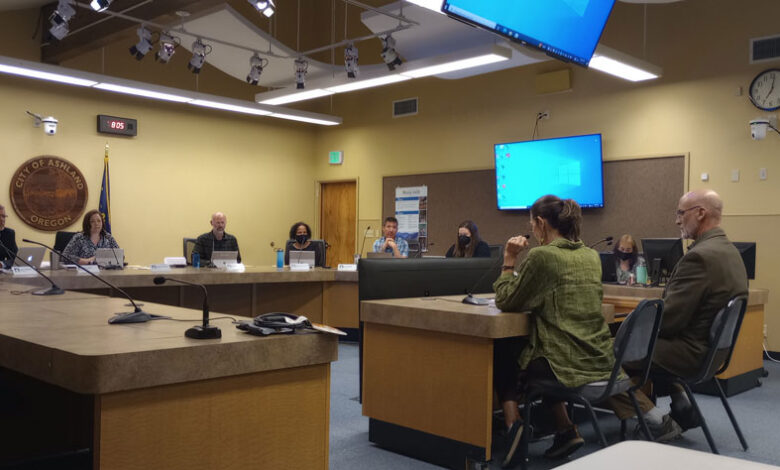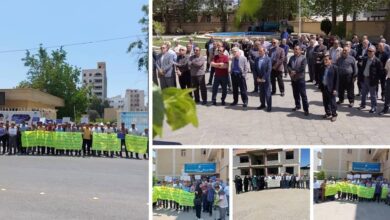Work on Ashland telecommunications ordinance sparks contentious debate – Ashland News

Second and final reading of proposed guidelines up for vote Tuesday
By Morgan Rothborne, Ashland.news
The city of Ashland’s telecommunication ordinance is being revised for the first time in nearly 30 years. The process has proved contentious.
Ashland City Council is expected to vote on a second and final reading of the new telecommunications ordinance Tuesday, April 2.
Members of Oregonians for Safer Technology feel Ashland City Council has not listened to six years of opposition and information from concerned residents. Kelly Marcotulli, the current head of the organization, said they wanted to see Ashand become a model city with a model ordinance for the rest of Oregon, protecting residents from what they say are the risks of 5G technology, namely electromagnetic radiation (EMF).
Councilor Jeff Dahle volunteered to spearhead the effort to create the city’s new ordinance due to his previous career as an engineer in radio and broadcast technology. He said he disagrees with, but does not dismis,s the concerns of residents such as Marcotulli.
“Public policy is all about balance. … (this ordinance is) a balance between 21st century realities of telecommunications and economic development while considering the concerns of Ashland residents,” he said.
The federal government regulates the telecommunications industry. Local agencies are not allowed to limit where towers are installed based on health concerns, and a city can’t have an ordinance that prohibits or has the effect of prohibiting, the installation of telecommunications facilities, he said.
Ashland’s previous ordinance was added to the Municipal Code in 1999 with a focus on establishing Ashland Fiber Network and regulating cable television. Quite a bit has changed in the intervening decades, but the technology hasn’t lost its essential character. It’s still data converted to 1’s and 0’s transmitted between devices. The difference is the devices are digital and the signals used to transmit that data have changed.
Cell technology is called “cell” because towers are laid out in a grid — like a honeycomb — to relay signals between each other, he said. That grid will change because 5G uses higher frequencies.
“The reason the telecommunications companies are trying to maximize frequencies is the ability to transmit more information. … The more 1’s and 0’s I can send in one second, the more information,” he said.
Higher frequency signals carry more information but since they can’t travel long distances, 5G telecommunications facilities will be placed closer together.
Those opposing 5G are concerned about electromagnetic fields, but these are only a frequency on the electromagnetic spectrum, Dahle said.
“At a high enough frequency, they have enough energy to knock electrons out of their electric shell, that’s ionizing radiation,” he said.
The most potent form of ionizing radiation life is continually exposed to is the sun. Sunbeams emit far more radiation than 5G, he said.
He said he created a designated folder to handle the hundreds of emails he has received while working on the ordinance. Most come from a dedicated number of residents sending repeated messages. Not all are in opposition; a significant number are in favor of 5G, he said.
Marcotulli said many of those in favor of 5G believe the technology will provide better cell phone reception. This is a misconception, she said. The technology really helps with streaming movies, downloading and sharing other forms of complex data and the expansion of the IOT or “internet of things.”
“Which is like, if you have a smart fridge it will use 5G to tell your cell phone that you’re running out of milk,” she said.
While OST doesn’t want to prohibit cell phones, they believe the potential benefits of 5G don’t compensate for what they say is the tower’s potential to start wildfires and cause myriad health problems for people. Some people, like herself, she said, are sensitive and experience health problems such as tinnitus, headaches and insomnia within 10 minutes of exposure.
“I have a disability, and if I have a disability I should be accommodated. I can’t really go into downtown Ashland because there’s a tower on the Ashland Springs Hotel and the EMF is very strong,” she said.
Ashland City Council approved the first reading of the draft telecommunications ordinance March 19 in a 5-to-1 vote, with Councilor Gina DuQuenne voting in opposition while Councilors Dahle, Bloom, Eric Hansen, Paula Hyatt and Bob Kaplan voted in favor.
Tensions surrounding the ordinance have run high. City Council and Mayor Tonya Graham were sent on Wednesday a vague and threatening-sounding email from an anonymous source demanding a moratorium on the ordinance.
During public comment at the first reading, Bruno Marcotulli accused Dahle of “gaslighting,” and dishonesty. He stated members of OST had raised $8,500 to pay for the services of telecommunications attorney Andrew Campanelli.
The city hired attorney Nancy Werner to draft the ordinance. Dahle stated she has been paid to date $3,116 in city funds for her services. This is not the final cost; the number will be available once the process to update the ordinance is complete.
Kelly Marcotulli and others in OST feel because the city has not hired Camponelli or invited him for a dedicated study session that their voices have not been heard. She stated they originally felt Dahle was an ally but now believe he was misleading and that “something’s fishy,” with the city.
Dahle said those opposing the technology and the ordinance were free and welcome to lobby the city and share their opinions in respectful public discourse but strongly defended his integrity.
He asked city staff to create the public comment period on the city website so those comments could be reviewed and potentially incorporated while the ordinance was being drafted. During the process he also met with Marcotulli and members of OST. Marcotulli confirmed three meetings in a year.
During these meetings, Dahle said OST members pressed for the city to hire Campanelli. Dahle stated the city declined this suggestion but he offered to look at a draft ordinance from Campanelli or solicit his comments on the city’s ordinance. Dahle said he was originally told “Campanelli doesn’t do that, he does his own thing.”
But near the end of the public comment period, a draft ordinance from Campanelli was submitted, it was reviewed and some of its elements were incorporated into the city’s ordinance, Dahle said. Marcotulli confirmed the $8,500 OST raised for Campenelli’s services was spent to obtain the draft ordinance which was submitted to the city. Without comparing the two documents she could not confirm the submitted draft had been incorporated.
Dahle said he was proud of the ordinance for its balance of competing demands from the public, the government and the pace of technology.
The new ordinance allows the city to shut off towers if they exceed FCC regulations. It also has a good point of leverage through emphasizing design standards for historic districts since Ashland has four such districts, Dahle said.
Installations for 5G will probably be in areas such as Siskiyou Boulevard where regulations aren’t as tight. Due to the expense in installing the technology and the city’s ordinance, Dahle predicted the roll out of 5G would be slower in Ashland than other places.
When asked if this could lead to Ashland experiencing a reduction in wireless capability as other areas install more 5G, Dahle said that is unknown but possible. Teslas, driverless cars and other technology in the IOT rely on 5G.
The city’s new ordinance would alter Ashland Municipal Code chapter 16, which regulates telecommunications installations on public-rights-of-way, said Ashland Community Development Director Brandon Goldman in a Wednesday email. Some telecommunications facilities will be unaffected by the ordinance change, such as a tower proposed for a Southern Oregon University rooftop, which is governed by AMC chapter 18, he said.
Public rights-of-way “include, but are not limited to, streets, roads, highways, bridges, alleys,
sidewalks, trails, paths, public utility easements and all other public ways or areas, including the subsurface under and air space over these areas,” according to the text of the new ordinance.
Email Ashland.news reporter Morgan Rothborne at morganr@ashland.news.



